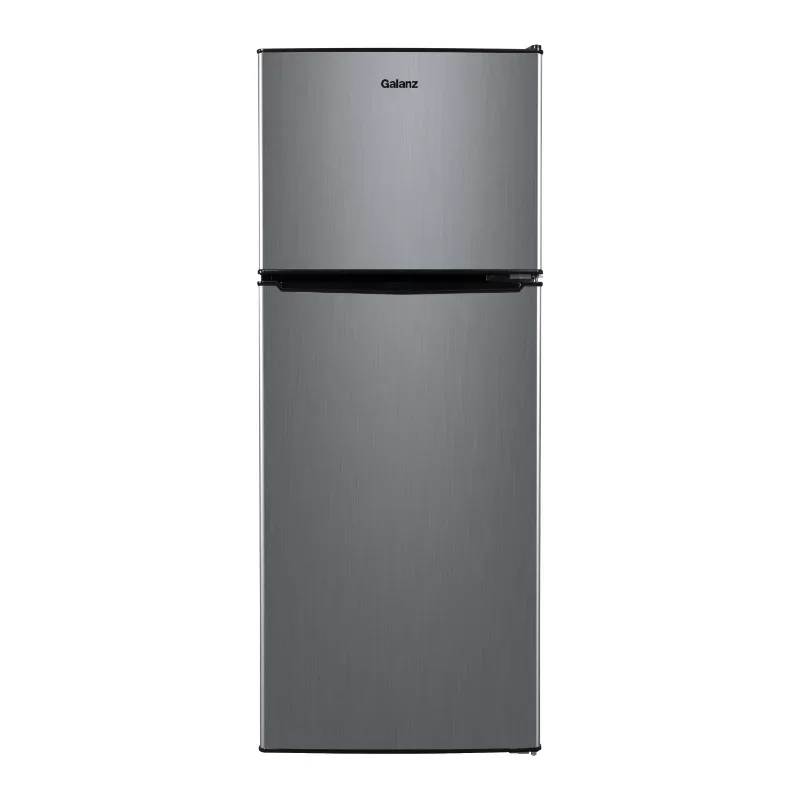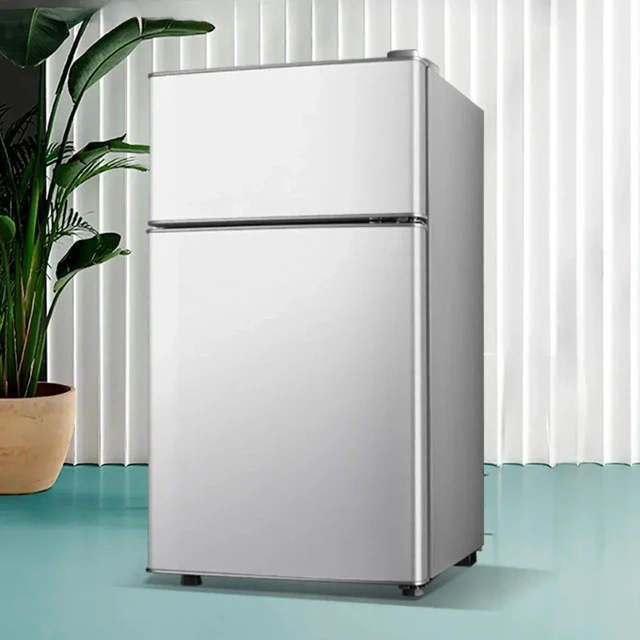Average Refrigerator Power Usage
Understanding the energy consumption of your refrigerator is essential for managing your household’s electricity use.

Identifying Your Refrigerator’s Wattage
To discover your fridge’s wattage, look for the nameplate. You’ll typically find volts (V) and amps (A) listed. Multiply these numbers to get the wattage.
For instance, a fridge may have a nameplate reading of 115V and 4.5A. Calculate as follows:
- 115V x 4.5A = 517.5 watts (W)
Since refrigerators cycle on and off, they don’t use maximum power at all times. Divide the full wattage by three to get an average operational consumption.
- 517.5W / 3 = 172.5 watts (average running wattage)
Impact of Size, Age, and Features on Energy Consumption
Size: Larger fridges consume more power. A smaller unit generally uses less energy.
Age: Older models are less efficient, using more electricity to operate.
Features: Additional features like ice dispensers or water filters can increase consumption.
Knowing these factors helps estimate your refrigerator’s energy use. Always consider size, age, and special features when calculating electricity consumption.
Methods to Estimate Refrigerator Energy Use
Using Volts and Amps to Determine Wattage
To figure out your refrigerator’s wattage, check the nameplate for volts and amps. Multiply these values for the initial wattage. Then, divide by three for an average, since fridges don’t run full time. For example, say your fridge shows 120V and 3A:
- 120V x 3A = 360 watts (initial wattage)
- 360W / 3 = 120 watts (average running wattage)
Remember, this method gives an estimate of power used during active cooling periods, not the fridge’s constant draw.
Interpreting the Energy Guide Label for Annual Consumption
Energy Guide labels are helpful. They show yearly electricity use and estimated costs. To calculate daily wattage, divide the yearly kilowatt-hour (kWh) figure by 365, then by 24 (hours a day). Multiply by three to get the fridge’s wattage. For example, if the label indicates 730 kWh/year:
- 730 kWh / 365 days = 2 kWh/day
- 2 kWh/day / 24 hours = 0.083 kWh/hour
- 0.083 kWh x 1000 = 83 watts/hour
- 83 watts x 3 = 249 watts (estimated wattage)
This method provides a broader view of the fridge’s energy use across the whole year.
 Factors Influencing Refrigerator Efficiency
Factors Influencing Refrigerator Efficiency
The Role of Internal Temperature Settings
Keeping your fridge’s temperature in the optimal range is crucial for efficiency. Too cold, and it works harder, using more energy.
Aim for 3-5°C (37-41°F) in the fridge and -18°C (0°F) in the freezer.
You’ll save energy and your food stays fresh.
Effect of Condenser Coil Cleanliness on Efficiency
Dust on condenser coils makes your fridge work harder.
A harder working fridge uses more electricity.
Clean these coils regularly, at least twice a year, to maintain efficiency and save on energy bills.
Importance of Door Seal Integrity
A fridge with a poor seal loses cold air. When cold air leaks, energy waste happens.
Make sure seals are tight and intact.
If you spot damages, replace the seals quickly. This will keep your fridge efficient.
Reducing Energy Consumption
Reducing your refrigerator’s energy consumption can lead to significant savings on your utility bills. Here are some effective strategies to optimize efficiency and minimize power usage.
Optimizing Refrigerator Temperature
Setting your refrigerator to the ideal temperature can prevent it from overworking, which wastes energy. Keep the fridge between 3-5°C (37-41°F) and the freezer at -18°C (0°F). This balances energy use with food safety.
Maintenance Tips for Enhancing Efficiency
Regular maintenance ensures your refrigerator runs efficiently. Clean the condenser coils twice a year to promote better heat release. Check the door seals frequently; replace them if they’re damaged. This keeps the cold air in and the hot air out.
Strategic Use of the Refrigerator and Reducing Open Door Time
Be mindful when using your fridge. Organize contents for quick access, and avoid leaving the door open too long. This reduces the amount of warm air entering, which makes your fridge use more energy to cool down again.
Energy-Efficient Refrigerator Models
When choosing a new refrigerator, energy efficiency is key. Look for models with high efficiency to reduce electricity use and cost.
Advantages of ENERGY STAR? Certified Appliances
ENERGY STAR? certified refrigerators are designed to save energy. They use less power than standard models, helping you save on your electric bill over time. These appliances are tested for their efficiency and reliability, often surpassing the minimum government standards for energy consumption. By opting for an ENERGY STAR? certified refrigerator, you not only contribute to environmental conservation but also benefit from lower operating costs.
Choosing an ENERGY STAR? certified fridge could lead to significant savings. They can save about $300 on energy bills over their lifetime compared to non-certified models. Plus, with rebates offered by many energy companies, initial costs can be offset.
Exploring the Features of Smart Refrigerators
Smart refrigerators come with advanced features that support energy saving. They often include:
- Temperature control via a smartphone app, conserving energy by avoiding overcooling.
- Alerts for open doors to prevent cold air from escaping.
- Monitoring systems that track energy use, so you know when power draw is high.
Smart technology in refrigerators may offer convenience, such as noticing if you’re running out of milk. But it’s their ability to maintain efficiency that truly sets them apart. They’re designed to learn your habits and adjust cooling accordingly, avoiding unnecessary energy use and saving money on your bills.
Cost Insights
Gaining insight into your refrigerator’s energy costs can be eye-opening.
The fridge can take up more than 10% of your home’s electricity. Its runtime makes it a significant player on your bill.
Calculating Daily and Monthly Energy Costs
To calculate daily costs, first find the fridge’s wattage per hour. Next, multiply by 24 for the daily wattage. For monthly costs, multiply the daily expense by the number of days in the month.
Comparing the Costs of Old vs New Models
Old fridges often use more power, leading to higher bills. Newer models are generally more energy-efficient. Upgrading could result in substantial savings over time.
 Tips for Lowering Your Refrigerator’s Energy Bill
Tips for Lowering Your Refrigerator’s Energy Bill
Reducing your refrigerator’s energy bill is possible with some savvy practices. Here’s how to lower your fridge’s power draw:
Best Practices for Fridge Usage to Minimize Power Draw
- Keep your fridge full but not overcrowded. This helps maintain cool temperatures with less effort.
- Regularly defrost to prevent ice buildup, which makes your fridge work harder.
- Place your fridge away from heat sources like ovens or direct sunlight to reduce workload.
- Limit door openings. Get what you need quickly to prevent warm air from entering.
- Use energy-saving modes if your fridge has them. These modes lower power use.
- Check and maintain door seals to ensure they are airtight, preventing cold air loss.
Incorporating these practices into your daily routine can lead to significant savings on your energy bills.
When to Consider Upgrading Your Refrigerator
It might be time for a new refrigerator if:
- Your current model is over ten years old; newer models are more efficient.
- Repairs are frequent and costly, indicating that your fridge is reaching the end of its life.
- Energy bills are high despite using power-saving tips; a new, efficient model can reduce costs.
Remember, while the upfront cost of a new refrigerator can be high, the long-term savings on your energy bills and the added benefits of modern features can make the investment worthwhile.
Final Thoughts
Understanding the beliefs and habits surrounding energy consumption can lead to better choices for both households and the environment. Careful consideration of energy-efficient options, regular maintenance, and mindful usage can go a long way in reducing the energy footprint of this essential appliance. Thus, embracing energy efficiency is not just about affecting your household budget but also about taking part in a collective initiative to protect the environment.
